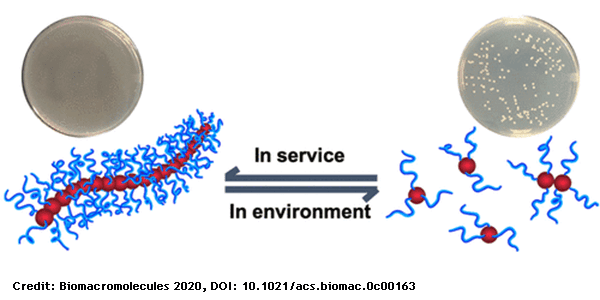A well-known issue with the use of antibiotics is that low levels of these antibiotics inevitably leak into wastewater and the environment. This not only contaminates water and food, but also reduces the antibiotics efficiency in the long term as it exposes bacteria to a low dose, causing antibiotic resistance. In a recent publication and one of the most read papers in Biomacromolecules in March, Hongjun Liang et al. of Texas Tech University Health Science Center presented a nano-antibiotic which consists of a cellulose backbone adorned with hydrophilic polymer brushes. In the body the bottle-brush polymer acts as a potent killer for bacteria, but once it is released into the environment, it is readily decomposed. As shown in the below figure, the polymer backbone is cut up into smaller, harmless pieces. Cellulase – an enzyme abundant in nature but not in the human body – breaks the backbone down to harmless fragments.

The team at TTU used small-angle X-ray Scattering (SAXS) on model liposomes mimicking either mammalian cells or bacteria cells to test the activity and selectivity of their bottle-brush polymers. They found that mammalian cell-like liposomes co-assembled with the polymers to form liposomes similar to the original liposome. In addition, liposomes loaded with a fluorescent die did not show any leakage, indicating that the polymers are not disrupting the mammalian cell membrane. Bacteria cell-like liposomes on the contrary, were shown to assemble into a 2D hexagonal phase when treated with the bottle brush polymer. 3D cubic phases were formed when they were treated with either the disassembled bottle brush or the side chains only. In another essay the authors showed that only the bottle-brush polymer acts as a membrane-active nano–antibiotic that kills bacteria. Therefore, they reason that although all three compounds (the bottle brush polymer, the disassembled polymer and the side chains alone) disrupt the bacteria membrane, only remodeling into the 2D hexagonal phase is irreversible and kills the bacteria.
































